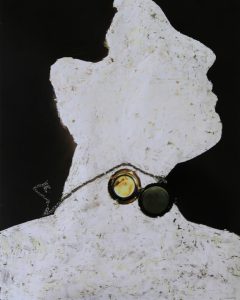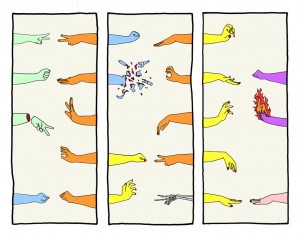
The following is part of SmokeLong‘s series Five from the Archive, which fulfills a need for teaching resources in the flash-narrative community and beyond. In this installment, Shreya Vikram takes a look at five stories in the SmokeLong story archive that employ repetition as a narrative element.
__________________________________
By Shreya Vikram
Repetition is the quality of sound that separates music from noise. We repeat images, words, syllables, syntaxes and phrases. We repeat ourselves naturally in our thoughts and speech. We process the world in these patterns, in writing and in life, using repetition to set rhythm, express tedium, tease out logic, lose logic, pull ourselves together, become unhinged, obsess, ruminate, and draw everything into a single cohesive unit. Besides being aesthetically pleasing, repetition gives the reader a thread to hold onto—on each encounter with the repeating structure, the reader also encounters its every other occurrence. The meaning of what is repeated changes depending on its context, which results in a layering of ideas. By patterning sounds, prose acquires another dimension of expression: the images, voices and settings that make up a story can be mirrored sonically through repetition.
These five stories from our archive sample the variety of ways in which repetition can shape how we read and write flash.

In Jessica Alexander’s The Pool Guy, the narrator ruminates over a failed marriage as she tries to start an affair with the pool guy. The piece is alternatively jarring, depressing and hilarious. The repetition emphasises her obsession with picking apart her marriage and trying to make sense of it, even as she loses control and becomes increasingly unhinged. It also increases the momentum of the piece: “It was not a separation. Not a wound. My mouth is the wound. I wish you’d stuff yourself in my mouth.” The connections here are striking and would be impossible without the repeated word. The overall effect is harsh and unpleasant, increasing tension through extreme compression.
Prompt: Caren Beilin remarks that this piece “eschews a particular passion of realism, to blend sentences—to keep them contiguous through a false smoothness of logic”. Write a story that uses repetition to refuse this smoothness.

Lucas Southworth’s Hunger is a lyrical and powerful piece about the suffering and decay that we turn a blind eye to and sometimes participate in. Hunger’s repetition creates a dark fairytale of a story, using a distinct narrative voice that is as grim as it is playful—much like The Thousand and One Nights, which Southworth cites as inspiration. This piece is an excellent example of how integral repetition is to the natural rhythms of our speech, and how it can be manipulated to tease out a certain mood or character. The voice, addressing an unnamed listener, is alternatively cajoling and accusatory, and the nature of both speaker and listener comes through in the modulations of this monologue.
Prompt: Write a piece in the form of a narrator telling a story to an unnamed ‘you’, using repetition to control the modulations of voice and set the mood.

Tabloid by Dinah Cox elicits an existential anxiety by repeating everything we fear to be true: that nothing we do to try to survive in a life that often feels unbearable will help. There is a tenderness in these details (“caring for your carpet”, “the elbow grease of spit-shined surfaces”) that only makes what comes afterwards more devastating (“…will not help”). With each repetition, Cox fulfils the reader’s expectation; we learn to look out for the next occurrence of “will not help”; we anticipate and dread it. By confirming our worst fears at every turn, she builds up a tension that coils and coils and finally breaks when the pattern is finally interrupted by something even worse: “Your only help will be your own dumb luck, made dumber by the sunrise, dumber by nightfall, dumb the whole live long day.”
Prompt: Write a story that uses repetition to create a sense of urgency and dread. As Cox does, break the repetition at the end by compounding the dread instead of relieving it.

Colleen Kearney Rich’s Things You Won’t Tell Your Therapist is a story in list form, lulling the reader in with relatively mundane details before it casually slips in J’s funeral towards the end—a startling turn, especially in that there’s no mention of how or when it happened. The repetition acts as a cohesive force, tying together events before and after the event in an extraordinarily small space (the story clocks in at just over 200 words).
Prompt: Write a story in the form of a list about a traumatic event. Don’t address the event directly: instead, allow the repetition to pull together smaller details that edge around the event and thus define it.

Andersonville by Lindsay Mariana Walker is a piece about the absurdity of grief, visualised in a place where it rains keys. In the frenzy, an unnamed ‘you’ disappears and the narrator first waits, shovelling keys around and looking out for a reappearance, and then gives up. As Walker comments, the keys are both the problem and the solution, of which there appear to be infinite variations. The repetition of images (the keys) mirrors the repetition of language. The latter gives a sense that the narrator is trying to cope—make sense of things by returning to tedious, repetitive activities. But later it becomes a sign that the world is slipping out from under our protagonist, of which we get a glimpse in the last image: “You weren’t coming back and I wanted to watch. I missed the air. I wanted to swim. I wanted a lock. I wanted to feel little gold teeth under my legs.”
Prompt: Write a story that incorporates repetition as a narrator’s response to surreal elements.
Additional SmokeLong Quarterly Flash incorporating repetition:
There are a thousand ways to love a snake but only one way to kill it.
The Sleeping of the Stones or Mae and Her White Teeth
New Yorker Story About Michigan
_________________________________
 Shreya Vikram is a writer based in India. A Dorothy West Scholar, she has been recognised by the Adroit Prizes for Prose. Her work has appeared or is forthcoming in SmokeLong Quarterly, Hobart Pulp, Rumpus, Up the Staircase Quarterly and elsewhere.
Shreya Vikram is a writer based in India. A Dorothy West Scholar, she has been recognised by the Adroit Prizes for Prose. Her work has appeared or is forthcoming in SmokeLong Quarterly, Hobart Pulp, Rumpus, Up the Staircase Quarterly and elsewhere.

 The core workshop of SmokeLong Fitness is all in writing, so you can take part from anywhere at anytime. We are excited about creating a supportive, consistent and structured environment for flash writers to work on their craft in a community. We are thrilled and proud to say that our workshop participants have won, placed, or been listed in every major flash competition. Community works.
The core workshop of SmokeLong Fitness is all in writing, so you can take part from anywhere at anytime. We are excited about creating a supportive, consistent and structured environment for flash writers to work on their craft in a community. We are thrilled and proud to say that our workshop participants have won, placed, or been listed in every major flash competition. Community works.